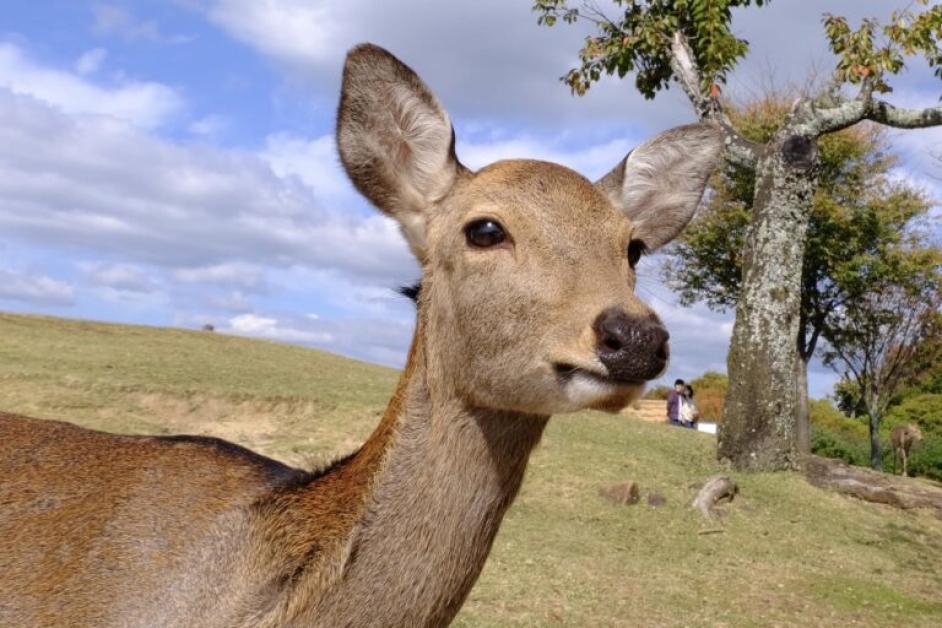- Japan’s Nara city is famous for its sacred deer, protected for a millennium as “messengers of the gods” according to Shinto religious tradition, and today also a valuable tourism resource.
- In recent years, genetic analysis by Japanese researchers has found that Nara’s protected deer population has become genetically isolated over its history. But a nationwide deer population boom now threatens to end the Nara deer’s long isolation, potentially bringing diseases transmissible to humans, the scientists warn.
- In addition, deer overpopulation can harm farmers’ livelihoods and upset the balance of ecosystems. The Nara prefectural government is leading efforts to minimize community conflicts and ecological damage from both protected and “ordinary” deer.
- However, the researchers warn that even stronger deer management measures, including installing more deer-proof fences and expanded culling, may be necessary to address conservation and community conflict issues.
Nara, a city in central Japan and an ancient national capital from 710 to 784 C.E., is today perhaps best known for its “sacred” deer.
According to legend, Takemikazuchi-no-mikoto, a deity in the Shinto pantheon, was carried by a sacred deer to Nara’s Kasuga Taisha Shrine upon its founding in 768, more than 1200 years ago, “for the prosperity of the nation and happiness of the people.” Ever since, deer living near the shrine have been protected, more or less, as “messengers of the gods.”
These days, roughly 1,300 sacred deer mingle freely with tourists in the 660-hectare (1,630-acre) Nara Park, a public space that includes Kasuga Taisha Shrine, Buddhist temples and a protected forest. The grounds, shrine and temples draw roughly 13 million visitors annually. As tourists snap photos, the animals eagerly wait to be hand-fed “deer crackers” purchased from park vendors.

In recent years, Japanese researchers have used genetic analysis to determine whether Nara’s deer are truly unique. They found that the population’s long history of protection has isolated their gene pool, making them genetically distinct, though not a separate species, from the deer in surrounding areas.
However, the strong protection measures have been called into question in recent decades as the Nara deer have been caught up in conservation and community controversy.
Across Japan, populations of sika deer (Cervus nippon) have exploded over the past 40 years, including around Nara. Now, the same researchers who revealed the sacred deer’s genetic distinction have discovered the protected deer are venturing outside the sanctuary and breeding with outside populations. They worry that “ordinary” deer may soon enter the protected area, potentially bringing infectious diseases with them.
Whether sacred or ordinary, protected or not, the overabundance of deer is also creating conflict with the shrine’s surrounding community as the animals damage crops, forests and habitat.
That leaves Nara authorities faced with difficult questions: Should the sacred Nara deer be kept isolated, and, if so, how should the surrounding “ordinary” deer be dealt with to achieve that goal?

Managing a living, moving ‘monument’
Shrines are sacred places of worship under Shintoism, one of Japan’s major religious traditions. And those shrines have inadvertently been an aid to long-term land conservation, with small groves and even entire mountains declared sacred since ancient times. Kasuga Taisha Shrine, for example, has not only protected the Nara deer, it has forbidden logging for a millennium on Mt. Kasuga, the forested summit behind the shrine and part of Nara Park.
“Often these kinds of aesthetic and spiritual considerations [went] hand in hand with more pragmatic and economic considerations” such as preventing erosion and restricting public access to forest resources, Aike P. Rots, a professor at the University of Oslo who studies the relationship between Shintoism and conservationism, told Mongabay.
Deer are likewise considered sacred animals in Buddhism, Japan’s other major religion, which was entwined with Shintoism until forcibly separated by the Meiji government in 1868. Nara’s Kasuga Taisha Shrine even merged with neighboring Kofukuji Temple at one point in its history.
Despite the rich spiritual heritage of Nara’s deer, Rots said that few Japanese perceive them today as sacred beings, but rather as a cultural tradition and part of the “cute” Nara tourism experience. Still, Nara’s four-legged icons are “definitely different from other deer — definitely out of the ordinary,” he said.
So special, in fact, that the Nara deer were protected by the Japanese government as “Natural Monuments” in 1957, with Kasuga Taisha Shrine renouncing ownership over the animals.
A modern protection and management plan for the Nara deer was created in 1985 as the result of a lawsuit with farmers who sued over crop damage. That settlement created four concentric zones around Kasuga Taisha Shrine: zones A and B cover the protected Nara Park; zone C acts as a buffer where deer may be removed but not harmed; while the deer population is subject to control measures in zone D, although culling didn’t begin there until 2017.
Experts note that, historically, deer in zones C and D were not considered sacred. However, to complicate matters, some of the land in those two zones was included in the 1957 Natural Monument designation, making population control measures there a delicate business.

The researchers analyzing the Nara deer’s DNA warn that more decisive action may be needed. In a 2024 paper, they reported that while only deer of the protected lineage were found inside zones A and B, both ordinary deer and deer of mixed lineages roam in zone D.
Importantly, in the near future, “Interbreeding populations may expand into the sanctuary,” the authors wrote. “Ordinary deer could soon replace the deer revered and protected by the people of Nara.”
The reason for this deer demographic shift is Japan’s fast-expanding wild deer population, study lead author and Kobe College lecturer Toshihito Takagi told Mongabay. The boom was likely due to natural habitat expansion, as Japan’s forest industry and rural population declined, as the nation shifted its fuel sources from wood to electricity and gas, and as wildlife protection policies changed.
The country’s deer population (excluding Hokkaido, the northernmost of Japan’s main islands) rose from 250,000 individuals in 1989 to a peak of 2.5 million in 2014, with its range expanding by roughly 70%. By 2021, culling had reduced deer numbers to 2.2 million.
“No one thought deer would multiply to such an extent, whether across Japan or in Nara,” Takagi said. He emphasized that practices to conserve Nara’s protected deer and control the ordinary ones “need to be modified to fit the situation.”
“Keeping deer out of Nara’s management zone — which doesn’t mean just culling, but also installing further deer-proof fences — would help prevent agricultural damage and guard against disease transmission from animals to humans by keeping the Nara Park population isolated,” Takagi explained, calling such measures “a return to the traditional approach.”

Deer overpopulation disrupts agriculture, ecosystems
In the eyes of farmers in and around Nara, the deer are often seen as crop-munching pests. Ryhan M.Y., a student at Kyoto University’s Graduate School of Agriculture who previously worked on a farm near Nara, told Mongabay that ordinary (not protected) deer would strip the farm’s new yuzu saplings of fresh green shoots within a day of being planted. In springtime, the deer also fed on the young shoots of tea plants, an “infuriating” experience for the farmer who worked hard to grow tea organically.
“My boss … was very peeved because there was nothing he could do at that point because he wasn’t certified to cull deer,” M.Y. said. “The best you can do is just put up an electric fence to keep the deer out.”
Among M.Y.’s local acquaintances were some who were quite attached to the protected deer, while others (especially drivers encountering them on roads) felt “like they’re a bit of a pest,” she said. “There’re just so many of them, they’re not just confined to Nara Park anymore.”
Nara authorities are trying to keep the peace between all their constituents: farmers and deer-friends alike.
In 2016, Nara prefecture relied on an expert committee to revamp its deer management plan, installing deer-proof fences and beginning a culling program in zone D. In the past, various factors had hindered action, including the lack of a central entity responsible for the deer, fear that culling would harm tourism, and poor communication between authorities and farmers.
Although the management plan has reduced the agricultural damage, Takagi and his colleagues’ 2024 paper warns that the deer problem still could “become more serious” unless officials beef up countermeasures. Nara’s agricultural cooperative didn’t respond to Mongabay’s request for comment.
In addition to grazing on crops, deer overpopulation poses a threat to Japan’s ecosystems, with the hungry mammals preventing forest regeneration and causing erosion.

In the 2000s, experts raised an alarm, saying that understory grazing by Nara’s protected deer may be impeding the growth of young trees in the long-protected forest on Mt. Kasuga behind Kasuga Taisha Shrine, altering the fully protected forest ecosystem. Since 2016, Nara prefecture’s deer management plan has included installing deer-proof fences on Mt. Kasuga; the prefecture also has a separate conservation plan and expert committee dedicated to the forest.
Their vigilance may be working. A 2023 survey of deer understory damage in and around Nara Park found that, overall, the deer were having a small impact, a Nara prefecture official who asked not the be named told Mongabay. The prefectural government and its expert committee are proceeding cautiously as they discuss how to continue protecting “sacred” deer while repelling other deer.
“The expert committee is currently considering whether deer in the buffer zone [zone C] should also be subject to culling, in order to prevent agricultural damage and maintain standards for protection and management,” the official said.
They noted that researchers involved in the DNA analysis work are also included on the expert committee, with their scientific findings weighed alongside community, cultural and spiritual concerns.
Banner image: One of the roughly 1,300 sacred Nara deer seen close up. This sika deer (Cervus nippon) population has been isolated and protected by both Shinto and Buddhist religious traditions for more than 1,000 years. Image by Annelise Giseburt.
Meet Japan’s Iriomote and Tsushima cats: Ambassadors for island conservation
Citations:
Abe, H., Kume, T., Hyodo, F., Oyamada, M., & Katayama, A. (2024). Soil erosion under forest hampers beech growth: Impacts of understory vegetation degradation by sika deer. CATENA, 234, 107559. doi:10.1016/j.catena.2023.107559
Takagi, T., Murakami, R., Takano, A., Torii, H., Kaneko, S., & Tamate, H. B. (2023). A historic religious sanctuary may have preserved ancestral genetics of Japanese sika deer (Cervus nippon). Journal of Mammalogy, 104(2), 303-315. doi:10.1093/jmammal/gyac120
Takagi, T., Torii, H., Kaneko, S., & Tamate, H. B. (2024). The sacred deer conflict of management after a 1000‐year history: Hunting in the name of conservation or loss of their genetic identity. Conservation Science and Practice, 6(3). doi:10.1111/csp2.13084
Takatsuki, S. (2009). Effects of sika deer on vegetation in Japan: A review. Biological Conservation, 142(9), 1922-1929. doi:10.1016/j.biocon.2009.02.011
FEEDBACK: Use this form to send a message to the author of this post. If you want to post a public comment, you can do that at the bottom of the page.



